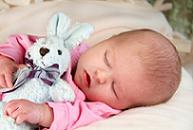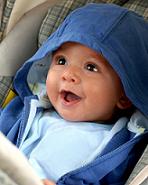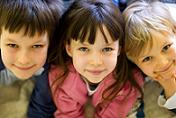Developmental Stages of Children
Children all go through developmental stages. Science proves that human development follows a predictable pattern.

Generally children learn to creep, then to crawl, then move to standing and walking. Speech also follows a predictable pattern. Children coo, then babble, then form simple words and move on to form 2-3 word sentences.
Preschoolers will learn a wide variety of skills between the ages of 3-5.
Knowing the sequence of development helps child care providers to guide children through each of the stages. It makes it easier to plan age-appropriate activities for all the children in your care.
Due to a vast array of personalities and environmental factors, all children at the same age will not have the exact same language or social skills. Their motor development and cognitive skills will not be equal.
Do not be concerned if children are a bit faster or slower than general guidelines. Children mature at different times; therefore this list is only a guide
to be used when planning your curriculum.
0-3 MONTHS

- Follows people and objects with eyes
- Can lift head for a few minutes
- Sets own schedule
- Stares at bright colors and other objects
- Starts to reach with hands
- Can recognize parents
- Smiles at familiar people
- Laughs and Coos
3-6 MONTHS

- Explores hands and feet
- Puts most objects in mouth
- Begins to develop hand eye coordination
- Rolls on own
- Sits with support
- Loves to bounce
- Likes Peek-a-Boo
- Imitates sounds
- Transfers objects from one hand to another
- Can recognize voices
- Can stand when helped into position
6-12 MONTHS
- Can sit on their own
- Learns to crawl
- Uses fingers and thumbs
- Self feeds with finger foods
- Pulls self into a standing position
- Can walk holding furniture or an adult’s hands
- Recognizes their own name
- May still be shy around strangers
- Speaks and understands some common words
Developmental Stages of Toddlers
ONE YEAR OLD
- Crawls extremely well
- Can get to feet unassisted
- Can stand alone
- Drinks pretty well from a cup
- Toward the end of this period, children can walk without help but still have trouble walking around objects
- When running has some difficulty stopping
- Attempts to get dressed unassisted
- Can stack 2-6 objects
- Moves up and down stairs in a crawling fashion
- Likes to scribble, uses the whole arm to “draw”
- Can help put toys away
- Uses gestures such as pulling or pointing to get adults attention
- Uses 1-2 words to convey an entire thought
- Can identify a few body parts if someone names them (i.e. Where is your nose?)
- Likes rhymes and songs and will try to sing along
- Can follow simple directions
- Can name many objects correctly
- Can place several small items in a container
- Likes looking at picture books
- When offered a second object will pass the first object to the other hand. This is a neurological development considered important. It’s called passing the mid-line
- Starting to assert independence and wants to do many things without help
- Imitates the actions of adults when playing
- Tantrums may begin during this year if tired or frustrated
- Likes being around other children but does not play cooperatively
- Likes attention from adults, will willingly give hugs and kisses
TWO YEARS OLD
- Easily walks around obstacles
- Can climb stairs alone using two feet per step
- May become toilet trained in this stage
- Can use feet to make riding toys “go”
- Can throw a ball underhand without falling down
- May still fall when balancing on one foot or jumping up and down
- Can turn doorknobs to open doors
- Can stack 4-6 objects
- Can unbutton large buttons or unzip zippers
- Refers to themselves as “me” instead of by name
- Understands the word “mine”
- Asks “what’s that?” repeatedly
- Most of their speech is clearly understood
- Talks about people and objects not present
- Is an active listener when being read to, likes to turn pages, point, etc.
- Can verbalize a need or want
- Uses 3-4 word sentences
- Can put objects together and take them apart
- Likes to name objects in picture books
- Recognizes pain and can point to its location
- Will use objects for purposes other than intended (i.e. a block becomes a car)
- Knows first and last name
- Starts to follow rules
- Can use physical aggression if angry or frustrated
- Likes to “help” with everyday household chores
- Watches other children play, does not typically join in, and likes to play alone
- Is not fond of waiting or taking turns
Developmental Stages of Preschoolers

THREE YEARS OLD
- Builds a tower of eight or more blocks
- Can wash and dry hands
- Needs very little assistance with eating
- Walks up and down stairs using alternating feet
- Can jump from the bottom step landing on both feet
- Can pedal a small tricycle
- Holds crayon or marker using first two fingers and thumb instead of the fist in earlier stages
- Typically shows a hand dominance in this stage
- Uses multiple word sentences
- More nouns and verbs in language, starts using descriptive words
- Likes books, tries to read to others
- Great strides in speech, uses descriptive words, places an “s” on words to indicate plural even on words already plural (i.e. mices)
- Likes stories with guessing involved
- Can count to ten
- Can name 5-6 colors
- Drawings look like actual objects
- Understands some right and wrong
- May use a special blanket or stuffed toy for comfort
- Very friendly, laughs a lot
- Sometimes has nightmares or fears (i.e. monsters)
- Shows affection for children who are younger or hurt
- Not yet skilled at sharing or taking turns
- Plays parallel to another child instead of with
FOUR YEARS OLD
- Dresses unassisted
- Rides a two wheeler with training wheels
- Can use scissors
- Learns manners
- Talks well and frequently
- Catches a bounced ball
- Can fasten zippers or buttons
- Can cut soft food with knife
- Learning to take turns
- Can skip
- Understands the concept of time
- Usually gives up nap
FIVE YEARS OLD
- Knows the alphabet
- Prints letters and name well
- Brushes or combs own hair
- Likes organized games and insists upon following the rules
- Jumps over small objects
- Reads simple words
- Uses words to describe emotions
- Eye hand coordination greatly improved
- Capable of making a sandwich
As you can see, these are the basic developmental stages that children go through. Do not worry if a child does not progress through the developmental stages at the same time as another child. Some children may progress at a faster or slower pace than others.
from developmental stages to daycare tips
from developmental stages to simply daycare home
















